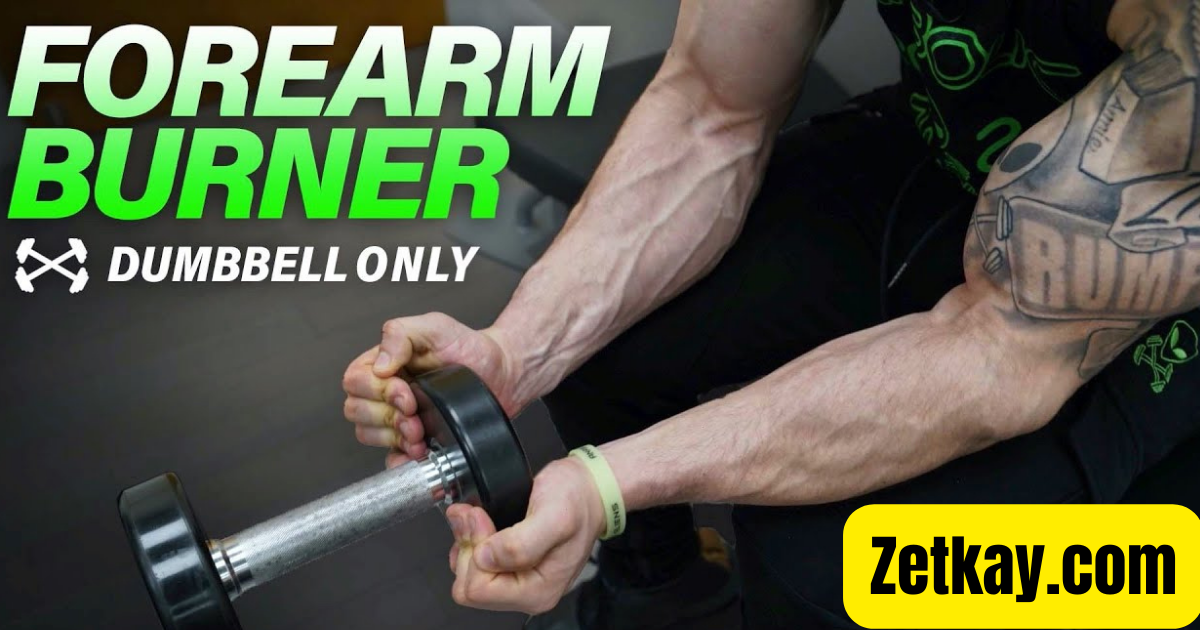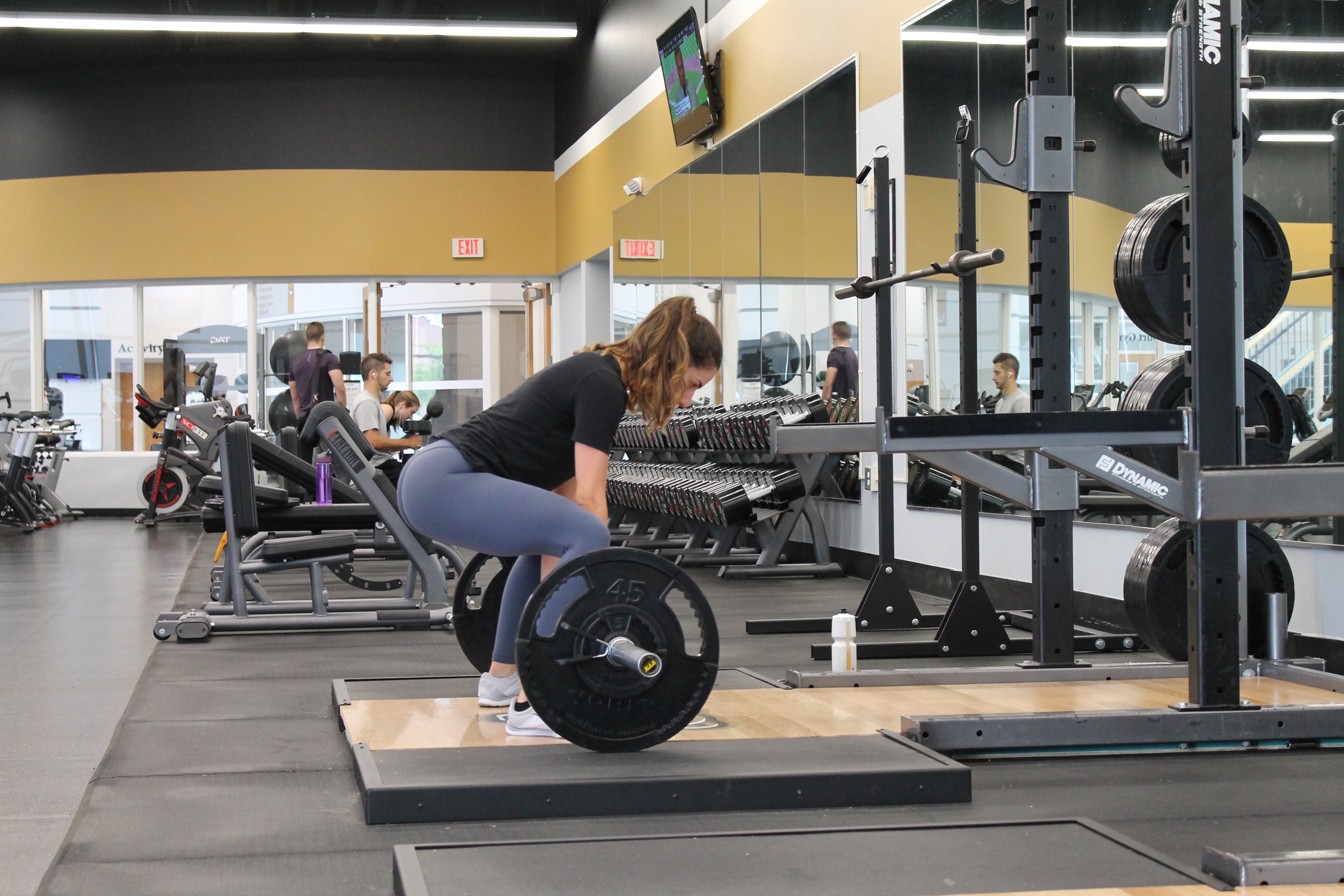Introduction
Forearm Dumbbell Exercises:Strengthen your grip and give your hands a workout with forearm exercises! You can do them at home with simple tools, or tackle them at the gym.
In this post, you’ll learn:
- The benefits of strong forearms
- Top dumbbell forearm exercises with easy-to-follow instructions
- Effective workout routines to target different forearm muscles
- Tips for proper form to avoid injury and maximize results
Overview:
Numerous forearm exercises, such as flexor and extensor movements, are included in this guidebook. Everything from anatomy to training schedules for novices, intermediates, and experienced athletes is covered. To develop strong, well-defined forearms, learn about appropriate form, progressive overload, and dietary advice.
forearm exercise with dumbbells
Farmer’s Walks: Carry heavy dumbbells for grip strength and overall forearm conditioning.Pinch Grips: Use weight plates or grippers to squeeze and hold for time for finger and hand strength. Start light and gradually increase weight. Control movement, don’t jerk weights. Keep forearms neutral, with no excessive wrist bend. Do 2-3 sets of 10-12 reps, 2-3 times a week.
how to exercise forearms with dumbbells
Tips: how to exercise forearms with dumbbells
- Focus on mind-muscle connection. Concentrate on engaging your forearms during each exercise.
- Control the movement. Avoid using momentum to lift the weights. Lower weights slowly and deliberately.
- Keep your forearms neutral. Don’t let your wrists bend back or forth excessively.
- Include these exercises in your regular workout routine. Aim for 2-3 sets of 10-12 repetitions, 2-3 times per week.
best dumbbell forearm exercises
1. Hammer Curls:
- Targets: Brachioradialis (main forearm muscle) and biceps.
- How-to: Hold dumbbells with a neutral grip (palms facing each other). Curl weights towards your shoulders, focusing on squeezing your forearms throughout the movement. Lower slowly and repeat.
2. Wrist Curls (Palms Up and Down):
- Targets: Wrist flexors and extensors.
- How-to (Palms Up): Sit with forearms resting on thighs, palms facing up. Curl weights by lifting your wrists, and squeezing at the top. Reverse for Palms Down curls.
3. Reverse Wrist Curls:
- Targets: Forearm extensors.
- How-to: Hold dumbbells with an underhand grip (palms facing down). Curl weights towards your forearms, feeling the squeeze on the backside. Lower slowly and repeat.
4.DUMBBELL FARMER’S CARRY
My favorite forearm exercise with dumbbells is like carrying groceries! It strengthens your forearms without a lot of movement, and it works most of the muscles in your arms too. You might see super strong athletes carrying giant weights in this exercise, but you don’t need to do that much. Instead, focus on using heavier weights so you can easily carry all your shopping bags in one go! While lighter weights and longer walks can help your stamina, this exercise is best done with heavier weights to build more strength.
5.DUMBBELL FINGER CURLS BEHIND THE BACK
Don’t let the strange name fool you, this is a great exercise for your forearms! It might feel harder at first because it uses your finger strength more than your whole hand grip. It strengthens your grip and the bend in your forearm, especially if you do a little extra squeeze at the top.
Here’s how to do it:**
- Stand with a slight knee bend and hold dumbbells behind your back, one in each hand. Keep your back straight and your core tight. Hold the dumbbells with your fingers, not your palms, facing your back.
- Curl your fingers up like you’re grabbing the dumbbells with your palms.
- Here’s the bonus move: Once the weights reach your palms, you can either lower them down or curl your wrists up towards your elbows, squeezing your forearms hard at the top.
- Slowly lower the dumbbells back to your starting position, holding them with your fingers again. Remember, only your hands and wrists should be moving during this exercise.
6. DUMBBELL FINGER CURLS
Just like the behind-the-back version, this finger curl exercise strengthens your grip and can also improve the bend in your forearm. It’s a great choice because you can move your wrists all the way down at the start, giving you a full workout.
Here’s how to do it:**
- Sit down and rest your elbows on your thighs. Hold dumbbells in each hand with your palms facing down and your wrists completely straight. The dumbbells should be cradled in your fingers, not your palms.
- Curl your fingers up like you’re grabbing the dumbbells with your palms.
- Here’s the bonus move for your forearms: Once the weights reach your palms, you can either lower them down or curl your wrists up towards the ceiling, like you’re flexing your forearms.
- Slowly lower the dumbbells back to the starting position, holding them with your fingers again. Remember, only your hands and wrists should be moving during this exercise.
7.REVERSE CONCENTRATION CURLS
Having trouble doing reverse curls while standing?Try some concentration curls instead! These allow you to concentrate on one arm at a time, which facilitates proper form maintenance. Your forearms will get stronger as a result of this.
Here’s how to do concentration curls:**
- Sit down and lean forward a bit. Tuck your elbow of one arm against the inside of your thigh, with your hand facing your leg. Imagine your shoulder blade pushing slightly out to make room for this position.
- Hold a dumbbell in your hand and curl it up towards your shoulder. When you reach the top, the weight should be close to your face.
- Slowly lower the dumbbell back down to your starting position. Repeat this for the desired number of repetitions, then switch arms and do the same thing with the other arm.
8. BENCH WRIST CURLS
Depending on how you hold the dumbbells, this exercise strengthens your forearms in a manner that other exercises cannot. This makes it distinctive.Here’s the breakdown:
- Palms-down grip: This works the same muscles as a regular wrist curl, strengthening the extension in your forearms.
- Palms-up grip: This works the opposite muscles, strengthening the flexion in your forearms (like doing a regular curl motion).
- Neutral grip (palms facing each other): This works a new area in between your forearms, helping you build more overall strength.
Here’s how to do bench wrist curls:
- Kneel in front of a flat bench. Lean forward and rest your forearms on the bench, with your elbows bent and hands hanging off the edge.
- Choose your grip (palms down, palms up, or palms facing each other).
- Start with the weights as low as possible (wrists bent down for palms-down grip).
- Squeeze your hands and curl the weights up as far as you can comfortably go (depending on your grip).
- Slowly lower the weights back down and repeat.
9. FARMER’S WALK
Farmer’s walk is like carrying a bunch of groceries at once! You pick up heavy weights (dumbbells or kettlebells) and walk around. It’s similar to what real farmers do all day, carrying different things around the farm. Because it takes a lot of effort to hold the weight, this exercise develops the forearms, particularly the fingers and wrists.
10. PALMS-UP WRIST CURL
This exercise is an excellent way to focus your forearms particularly! To strengthen those muscles, it makes use of dumbbells and your natural wrist movement.
Here’s how to do it:**
- Sit down on a chair, bench, or even a box. Hold a dumbbell in each hand.
- Rest your forearms on your thighs, letting your hands hang off your knees so your wrists bend backward.
- Curl your wrists up as high as you comfortably can, hold for a second, then slowly lower them back down to the starting position.
- Aim for 4 sets of 10 repetitions each.
- Remember to keep your wrists steady and breathe normally throughout the reps.
11.PALMS-DOWN WRIST CURL
This exercise is like the opposite of the wrist curl we just talked about. Though it works on other muscles, it’s another approach to strengthen your forearms using your natural wrist movement.
Here’s how to do it:**
- Sit down on a chair, bench, or even a box. Hold a dumbbell in each hand.
- Flip your hands over so your palms are facing down and your forearms are resting on your thighs.
- Curl your wrists up towards your ceiling, hold for a second, then slowly lower them back down to the starting position.
- Aim for 4 sets of 10 repetitions each.
- Just like before, keep your wrists steady and breathe normally as you do your reps.
12.GRIP CRUSH
The Grip Crush is like a supercharged wrist curl! While maintaining forearm strength, it concentrates even more on your grip strength.
Here’s how to do it:**
- Sit down on a chair, bench, or box. Hold a dumbbell in your left hand.
- Lean your left arm forward and rest it against your thigh for support.
- Let the dumbbell roll down your palm towards your fingers. Then, squeeze it as hard as you can, like you’re crushing it. While squeezing, curl your wrist up towards your shoulder.
- Repeat steps 2 and 3 with your right arm.
- Aim for 4 sets of 10 repetitions each arm. Important! Choose a weight that’s challenging but comfortable for you. Don’t try to lift too much weight too soon.
13.TOWEL DUMBBELL CURLS
This is an additional exercise to strengthen your forearms and grip strength. It’s kind of like a bicep curl, but with a wider grip that targets your forearms more.
Here’s how to do it:**
- Grab two dumbbells and wrap a towel around them a few times to create a thicker handle. Hold the towel in each hand.
- Stand tall with your feet shoulder-width apart.
- Curl the dumbbells up towards your shoulders, like a regular bicep curl, but keep your palms facing inwards. Imagine bringing your palms towards your shoulders as you curl.
- Lower the dumbbells back down slowly.
- Aim for 2 sets of 20 repetitions each.
- Remember to keep your back straight and your movements smooth throughout the reps.
14.ZOTTMAN CURL
This exercise is a popular for building strong forearms because it works multiple muscles at once.. This is how you do it:
Place your feet shoulder-width apart and stand tall. Hold a dumbbell in each hand with your palms facing your sides.
- Curl the weights up towards your shoulders like a bicep curl, but at the top, twist your wrists so your palms face your shoulders.
- Now, flip your hands over so your palms are facing down.
- Lower the dumbbells back down to your sides in a slow, controlled motion, like a reverse curl.
- Repeat this for 3 sets of 10-12 repetitions.
15.DRAG CURL
This curl is a bit different from a regular bicep curl. It works your forearms even more by making you “drag” the weights up your body.
Here’s how to do it:**
- Stand tall with your feet shoulder-width apart. Hold a dumbbell in each hand down by your sides, palms facing you.
- Curl the dumbbells up towards your chest, but as you curl, push your elbows back slightly, like you’re dragging the weights up your body. Imagine your elbows are tucked close to your sides throughout the movement.
- Slowly lower the weights back down to your starting position.
- Repeat this for 3 sets of 10-12 repetitions.
- Remember to keep your back straight and your elbows close to your sides throughout the exercise.
The Significance of Forearm Training
Forearm Dumbbell Exercises, Before immersing ourselves in the intricacies of specific exercises, it becomes paramount to apprehend the significance encapsulated within forearm training. The forearms assume a pivotal role in a myriad of activities, ranging from the mundane act of lifting objects to the maintenance of a robust grip strength. Disregarding the cultivation of forearms could potentially yield muscular imbalances, acting as impediments to holistic strength advancements. Moreover, the cultivation of well-defined forearms contributes not only to functional prowess but also bestows a visually appealing and harmoniously proportioned physique.

Unraveling Forearm Anatomy
To efficiently engage in forearm training, it becomes imperative to establish a foundational comprehension of the intricate anatomy characterizing this particular muscle cluster. Encompassing a diverse array of muscles, notably the flexors, and extensors, the forearm assumes responsibility for the articulation of the wrist and fingers, while also governing the regulation of opposing movements. Dumbbell exercises emerge as a remarkably versatile modality to selectively target both muscle clusters, providing an all-encompassing regimen for the enhancement of forearm strength and endurance.
Forearm Dumbbell Exercises or forearm exercises dumbbell
Wrist Curls
Instructions: Forearm exercises with dumbbells
- Sit or stand with a dumbbell in each hand, palms facing upward.
- Rest your forearms on a flat surface or your thighs.
- Gradually lower the dumbbells toward the ground by bending your wrists.
- Elevate the dumbbells by flexing your wrists.
Variations:
- Reverse Wrist Curls: Execute the same movement with palms facing downward.
Benefits:
- Targets the forearm flexors.
- Enhances wrist strength and flexibility.
Common Mistakes:
- Excessive weight usage leads to improper form.
- Raising the elbows during the exercise.

Reverse Curls
Instructions:
- Stand with a dumbbell in each hand, palms facing downward.
- Keep your arms extended and close to your body.
- Elevate the dumbbells by contracting your forearm extensors.
- Lower the dumbbells with control.
Variations:
- Hammer Curls: Perform the same movement with palms facing each other.
Benefits:
- Focuses on the forearm extensors.
- Boosts grip strength.
Common Mistakes:
- Swinging the body to lift the weights.
- Reliance on momentum over controlled movements.
Plate Pinch
Instructions:
- Hold a weight plate between your fingers and thumb.
- Extend your arms parallel to the ground.
- Pinch the plate and maintain it for a specified duration.
- Repeat with the other hand.
Variations:
- Experiment with different weight plates for progression.
Benefits:
- Targets finger and thumb strength.
- Enhances overall grip.

Common Mistakes:
- Failure to maintain a straight arm.
- Allowing the plate to slip.
Farmers Walk
Instructions:
- Hold a heavy dumbbell in each hand.
- Walk for a predetermined distance or time.
- Maintain an upright posture and engage your core.
Variations:
- Single-arm Farmers Walk: Hold a heavier dumbbell in one hand.
Benefits:
- Engages the entire forearm.
- Enhances grip strength and endurance.
Common Mistakes:
- Leaning forward or slouching.
- Inadequate use of challenging weights.
UNDERSTANDING FOREARM ANATOMY
Your forearms are like mini powerhouses, packed with muscles responsible for flexion, extension, and rotation of the wrist and hand. The four main players are the biceps brachii, brachialis, triceps brachii, and extensor carpi radialis longus and brevis. On the palmar side, you have the flexor carpi muscles, which flex your wrist and fingers.
Here are some tips for training your forearms:

- Don’t neglect them! Include dedicated forearm exercises like wrist curls, reverse curls, and finger extensions in your routine.
- Variety is key: Mix up exercises to target different muscle groups and functions.
- Squeeze it out! Focus on controlled movements and mind-muscle connection to maximize muscle activation.
- Go slow and heavy: Lighter weights with higher reps can be just as effective for building forearm strength and endurance.
Biceps brachii: This two-headed muscle on the front of your upper arm extends down to your forearm, helping you bend your elbow and supinate your forearm (turning your palm upwards). Think Popeye and his bulging biceps!

- Brachialis: Nestled deep beneath the biceps, this muscle also flexes the elbow but plays a vital role in overall arm strength.
- Triceps brachii: This three-headed muscle on the back of your upper arm extends your elbow and pronates your forearm (turning your palm downwards). Think of it as the counterpoint to the biceps.

- Extensor carpi radialis longus and brevis: These two muscles located on the back of your forearm extend your wrist and help straighten your fingers.
Forearm Workouts with Dumbbells
Having covered individual exercises, let’s now explore effective forearm workout routines utilizing dumbbells.
Beginner Forearm Dumbbells Workout (3 Days per Week)
Wrist Curls: 3 sets of 12-15 reps
- Initiate with a light to moderate weight.
- Emphasize proper form and controlled movements.
Reverse Curls: 3 sets of 12-15 reps
- Use a weight that challenges without compromising form.
- Maintain a consistent pace throughout the exercise.
Farmers Walk: 2 sets of 60 seconds
- Commence with a moderate weight, gradually increasing as strength improves.
Intermediate Forearm Workout (4 Days per Week)
Reverse Curls: 4 sets of 10-12 reps
- Increase the weight for added resistance.
- Concentrate on contracting the forearm ex-tensors.

Plate Pinch: 3 sets of 45 seconds
- Vary the challenge by experimenting with different weight plates.
- Focus on maintaining a straight and steady arm.
Wrist Curls: 3 sets of 15-20 reps
- Use a slightly heavier weight than in the beginner routine.
- Pay attention to both the upward and downward phases of the movement.
Farmers Walk: 2 sets of 75 seconds
- Gradually increase the weight to maintain a challenging grip.
Advanced Forearm Workout (5 Days per Week)
Plate Pinch: 4 sets of 60 seconds
- Utilize challenging weight plates to maximize finger and thumb strength.
- Focus on a consistent grip throughout the duration.
Reverse Curls: 4 sets of 8-10 reps
- Lift heavier weights to stimulate muscle growth.
- Prioritize controlled, slow movements.
Farmers Walk: 3 sets of 90 seconds
- Use a substantial weight to push grip strength to the limit.
- Ensure proper form and posture during the entire walk.
Hammer Curls: 3 sets of 12-15 reps
- Introduce hammer curls for variety and to target different forearm muscles.
- Emphasize a full range of motion.
Tips for Success
- Progressive Overload: Continuously challenge your forearms by gradually increasing weight or intensity.
- Proper Form: Maintain strict form to effectively target the forearms and reduce the risk of injury.
- Balanced Nutrition: Support muscle development with a well-rounded diet rich in protein, vitamins, and minerals.
- Rest and Recovery: Allow adequate time for forearms to recover between workouts to prevent over-training.

Pros and Cons of Forearm Dumbbell Exercises:
- Pros:
- 1. Targeted Development: Forearm dumbbell exercises provide targeted isolation for both flexors and extensors, aiding in balanced muscle development.
- 2. Versatility: A wide range of exercises, such as wrist curls, reverse curls, and plate pinches, allows for versatile workouts catering to different fitness levels.
- 3. Functional Strength: Strengthening the forearms contributes to enhanced grip strength, promoting better performance in daily activities and other workouts.
- 4. Adaptability: Dumbbell exercises are adaptable to various settings, making them suitable for home workouts or gym sessions.
- 5. Progressive Overload: Easy to implement progressive overload by increasing weights gradually, supporting continuous muscle growth.
- Cons:
- 1. Equipment Dependency: Forearm dumbbell exercises require dumbbells, which may not be readily available for everyone, limiting accessibility.
- 2. Risk of Injury: Incorrect form or using excessive weight can lead to injuries, particularly in the wrists and elbows.
- 3. Limited Range of Motion: Some exercises may have a restricted range of motion compared to other forearm training methods.
- 4. Time-Consuming: Performing a comprehensive forearm workout with dumbbells may take more time than simpler exercises, making it less suitable for those with busy schedules.
- 5. Potential Muscular Imbalances: Overemphasis on certain exercises without a balanced approach may lead to muscular imbalances in the forearms.

Positive Review:
Trans-formative Forearm Gains!
Doing dumbbell exercises for my forearms, like wrist curls, has been awesome! My forearms look and feel stronger. Anybody’s fitness level may be accommodated with these exercises, which have even made mundane chores like grocery shopping easier. Significant distinction!
Negative Review:
Challenging, but Not Without Drawbacks
Although there are certain drawbacks, forearm dumbbell workouts are excellent for strengthening the forearms. First, you need dumbbells, which can be a pain if you work out at home. Second, you gotta do the exercises exactly right to avoid hurting yourself. Some exercises, like plate pinches, can also feel weird and might not be for everyone. Finally, a thorough forearm workout can take some time, so it might not be the best option if you’re pressed for time.
Conclusion
Forearm Dumbbell Exercises, Incorporating forearm dumbbell exercises into your fitness regimen stands as a paramount undertaking to realize a physique characterized by equilibrium and aesthetic appeal. Whether you find yourself at the inception of your fitness journey or stand as a seasoned enthusiast, the exercises and workout blueprints delineated in this guide seamlessly adapt to your current fitness echelon and aspirations. Accentuate the importance of precise form, progressively amplify the intensity, and uphold a steadfast dedication to your training routine.

Fortified and well-defined forearms contribute not solely to overarching physical robustness but also augment functional fitness, catering to the demands of diverse daily activities. Make the conscious decision to prioritize forearm training, and observe a metamorphosis in both the visual allure and operational efficiency of your forearms.
Read More: 1 Minute Fitness Challenge Ideas: Elevate Your Workout Game
FAQs:
1. Q: Can I do forearm dumbbell exercises at home?
– A: Yes, forearm dumbbell exercises are adaptable for home workouts, requiring minimal space and equipment.
2. Q: How often should I train my forearms with dumbbells?
– A: 2-3 times a week is ideal, allowing for adequate recovery between sessions for optimal muscle development.
3. Q: Are there alternatives to dumbbells for forearm training?
– A: Yes, grip strengtheners and resistance bands can offer effective alternatives for forearm exercises.
4. Q: Can beginners incorporate forearm dumbbell exercises?
– A: Absolutely, beginners can start with lighter weights and gradually progress as strength and technique improve.
5. Q: Will forearm dumbbell exercises improve grip strength?
– A: Yes, these exercises, especially farmers’ walks and plate pinches, are effective in enhancing overall grip strength.

1 comment
[…] Workout Equipment: 7 Explosive Strategies Forearm Workout Chart: 4 Strategies for Powerful Arms Forearm Dumbbell Exercises: Referring to 5 Ultimate Guide 1 Minute fitness challenge ideas: Elevate Your Workout… Different Types of Dumbbells: 6 […]